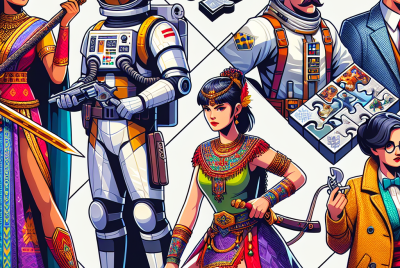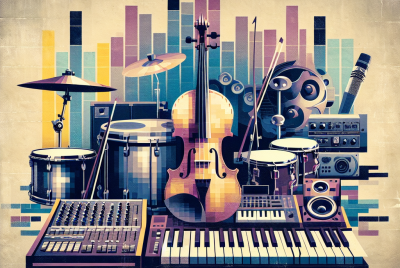Pixelated Symphonies: Celebrating Retro Game Music
The Birth of Retro Game Music: An Aesthetic Revolution
The golden age of video games, roughly spanning from the late 1970s to the early 1990s, marked a defining moment not only in gameplay but also in music composition. The music of that era is celebrated for its unique, layered melodies that captured the hearts of players around the world. The primary reason for this is the limited sound capabilities of early gaming hardware, which forced composers to innovate within strict confines, resulting in playful and memorable tunes.
Creative Constraints: The Magic of Chiptune
Chiptune music, created using sound chips from vintage computers and video game consoles, emerged as a major genre during this period. With frequencies and waveforms that might seem simplistic to the modern ear, composers produced music that utilized square waves, sawtooth waves, and noise channels to create rich aural experiences. The limitations of 8-bit and 16-bit systems required a deep understanding of melody, harmony, and rhythm, which ultimately fostered an astonishing level of creativity.
In consoles like the Nintendo Entertainment System (NES) and the Sega Genesis, composers crafted iconic soundtracks that remain etched in gaming history. Titles such as “Super Mario Bros.” and “The Legend of Zelda” introduced themes that have survived the test of time, becoming synonymous with the gaming experience itself.
Iconic Composers Shaping Retro Soundscapes
The success and popularity of retro game music are also attributable to visionary composers. Names such as Koji Kondo, Nobuo Uematsu, and Yoko Shimomura stand out as pioneering figures who transformed gaming scores into emotive storytelling mediums.
-
Koji Kondo, perhaps the most recognized, composed the scores for legendary Nintendo franchises like “Super Mario” and “The Legend of Zelda.” His ability to encapsulate the essence of a game within a few notes resulted in both iconic themes and seamlessly integrated soundtracks.
-
Nobuo Uematsu is renowned for his work on the “Final Fantasy” series. His composition style combined orchestral depth with Chiptune elements, creating an immersive auditory experience that heightened gameplay and emotional connection.
-
Yoko Shimomura broke new ground in game composition with her work on “Street Fighter II” and “Kingdom Hearts,” utilizing a more diverse instrumentation while still drawing from retro influences.
These composers built the foundation of video game music, which inspired future generations of artists and gamers alike.
The Cultural Impact of Retro Music
Retro game music transcends the gaming community; it has infiltrated mainstream culture through remixes, adaptations, and live orchestral performances. Dance clubs, cafes, and bars are increasingly embracing Chiptune and retro video game soundtracks, providing nostalgic relief to older audiences while introducing younger listeners to a rich sonic history.
One notable trend is the increase in video game concerts and orchestras performing beloved soundtracks in live settings. Events like “Video Games Live” have drawn massive crowds, celebrating the emotional weight and brilliance of compositions from iconic titles. These performances showcase the depth of music in gaming and how it contributes to storytelling.
The Rebirth of Chiptune in Modern Music
The nostalgia factor surrounding retro game music is catalyzing a revival in Chiptune and synth music as mainstream genres. Emerging artists are using modern technology to replicate those simple, synthetic sounds, blending them with contemporary music styles. Platforms like Bandcamp and Soundcloud have created a haven for these artists, allowing unique sounds reminiscent of early video game music to gain traction.
Furthermore, an entire sub-culture surrounding Chiptune exists, with events dedicated to the genre drawing passionate communities. Local Chiptune festivals, competitions, and showcases highlight the artistry involved in crafting music with vintage technology, proving that the retro aesthetic resonates with audiences today just as it did decades ago.
The Emotional Resonance of Retro Soundtracks
One compelling aspect of retro game music is its ability to evoke a sense of nostalgia and emotional connection. The melodies not only serve as background noise but as integral pieces of game narratives, reinforcing emotional stakes and enhancing player experiences. Soundtracks influence how players remember and relate to particular games, creating a bond that often lasts a lifetime.
For many players, the theme music becomes synonymous with the experiences tied to the game, securing its place in personal and collective memory. As a result, remakes and remasters often see the original soundtracks revisited, and any alteration can evoke strong reactions from long-time fans.
Incorporating Retro Elements in Modern Game Music
Many current game creators have adopted retro music styles to pay homage to the games of yesterday. This can be seen in indie games like “Shovel Knight” and “Celeste,” which skillfully intertwine retro music elements with contemporary gameplay mechanics. These compositions serve as a bridge connecting new audiences to the nostalgia of early gaming while establishing their own unique identities.
Moreover, video game soundtracks have seen a newfound respect in the industry, often garnering attention in terms of selling albums and gaining traction in streaming platforms. The game’s music is increasingly recognized not merely as a complement but as a fundamental component of the gaming experience, similar to film scores.
The Technological Evolution of Game Music
As technology has evolved, so too has the music that accompanies video games. Initially limited by hardware constraints, contemporary composers now employ advanced digital audio workstations, virtual instruments, and an expansive array of sound libraries. This evolution enables music professionals to create elaborate scores that combine orchestral music with electronic elements, immersing players deeper into their gaming adventures.
Despite this technological advancement, there remains a segment of the gaming community that treasures the classic sound of 8-bit music. Consequently, many modern artists seek to combine old techniques with new methodologies, ensuring the legacy of retro game music evolves while remaining true to its roots.
Celebrating Game Music: Community Engagement and Events
Community efforts are vital in keeping the love for retro game music alive. Online forums, social media groups, and fan sites contribute to discussions revolving around composers, techniques, and beloved tracks from childhood.
Community-driven events, such as local concerts or fan meet-ups, center around appreciating retro game music and connecting people through shared experiences. Collecting old game soundtracks or vinyl records has become a hobby for many, leading to an upsurge in the vinyl revival.
These gatherings not only celebrate the music but create spaces for discussions on how melodies shaped their gaming experience, effectively keeping the community of retro music lovers vibrant.
Exploring Retro Game Music Resources
For those interested in venturing into the world of retro game music, numerous online resources and platforms are available:
-
YouTube is filled with channels dedicated to gaming soundtracks, providing a treasure trove of nostalgic compositions for long-time fans and newcomers alike.
-
Spotify and Apple Music feature playlists compiling retro game soundtracks, making it easy to explore classics from gaming history.
-
Music forums and Reddit communities serve as platforms for fans to share their favorite tracks, discuss compositions, and explore the historical context behind them.
By engaging with these resources, enthusiasts of all ages can immerse themselves in the pixelated symphonies that have defined an era of gaming culture, celebrating and rediscovering the transformative power of sound in gaming.



